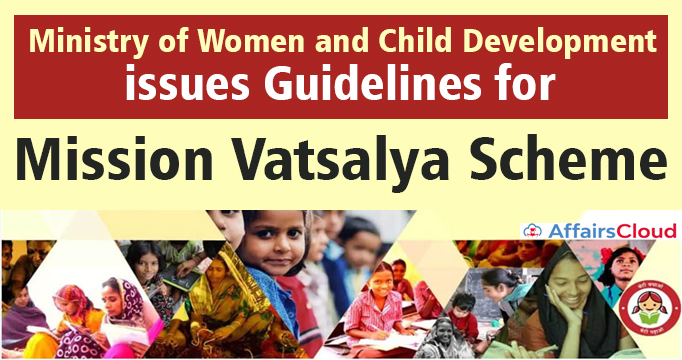
The Ministry of Women and Child Development(MoWCD), the nodal Ministry for ensuring the welfare of children, has issued guidelines for the Centrally Sponsored Scheme (CSS) “Mission Vatsalya”, formerly known as the Child Protection Services (CPS) Scheme, since 2009-10, for the welfare and rehabilitation of children.
- The primary objective of Mission Vatsalya is to ensure that every child in India has a healthy and happy childhood.
Genesis of Mission Vatsalya
Prior to 2009–10, the MoWCD had three schemes in place, namely
i.Programme for Juvenile Justice for Children in need of care and protection, and Children in conflict with Law;
ii.Integrated Programme for street children; and
iii. Scheme for assistance to homes for children (Shishu Greh).
All three schemes were merged into a single Centrally Sponsored Scheme (CSS) known as the Integrated Child Protection Scheme (ICPS), which was implemented by the MoWCD from 2009-2010.
- In 2017, the scheme’s name was changed to the “Child Protection Services” (CPS) Scheme. From 2021-22, the CPS Scheme has been subsumed into Mission Vatsalya.
Mission Vatsalya
i.Mission Vatsalya is a road map for achieving development and child protection priorities that are consistent with the Sustainable Development Goals (SDGs).
- With the motto “leave no child behind,” it emphasises Child rights, advocacy, and awareness while also strengthening the juvenile justice care and protection system.
ii.The provisions of the Protection of Children from Sexual Offences Act of 2012 and the Juvenile Justice (Care and Protection of Children) Act, 2015 (JJ Act, 2015) provide the basic foundation for carrying out the mission.
iii. It advocates family-based non-institutional care for children in difficult circumstances, with institutionalisation as a last alternative.
iv.Additionally, it strives to establish a sensitive, supporting, and coordinated ecosystem for children’s development; help States and UTs carry out the mandate of the JJ Act, 2015; and reach the SDG.
v.Components of Mission Vatsalya
- Improve functioning of statutory bodies
- Strengthen service delivery structures
- Upscale institutional care/services
- Encourage non-institutional community-based care
- emergency outreach services
- Training and capacity building
vi.Aim of Mission Vatsalya
- Support and sustain Children in difficult circumstances
- Develop context-based solutions for holistic development of children from varied background
- Provide scope for encouraging innovative solutions
- Cement convergent action
Specific Objectives of Mission Vatsalya
i.The administrative system prioritises children, maintaining the importance of the children in all mission-related operations and actions.
ii.To ensure Children’s right to Survival, Development, Protection and Participation
iii. Coordinate and network with all allied systems to promote convergent efforts for seamless service delivery to children in order to ensure appropriate inter-sector response at all levels.
iv.Achieving the best interests of children includes greater public awareness, educating the general public about children’s rights, vulnerabilities, and government-sponsored protection measures, and involving the community at all levels as stakeholders.
v.To seek the assistance of Panchayats and Municipal Local Bodies at the village, ward, and urban cluster levels within the urban municipal ward, for sustained assessment of the issues deserving attention, implementation of suitable interventions, and regular monitoring, in order to create a robust social safety net for children.
Framework at Central Level
i.Under the Chairmanship of the Secretary, MoWCD, the Mission Vatsalya Project Approval Board (PAB) would scrutinize and approve the annual plans and financial proposals received from the States/UTs for the release of grants under the scheme.
- Secretaries of the departments of Home Affairs, Social Justice and Empowerment, Panchayati Raj, Rural Development, Housing and Urban Affairs, Labour, Youth Affairs and Sports, Department of School Affairs and Literacy, and the National Institution for Transforming India (NITI) Aayog CEO, will be PAB members.
ii.The States/UTs must submit their duly filled financial proposals in the formats specified, along with their implementation plans, for scrutiny.
iii. The PAB will get the appropriate secretarial help from the Mission Vatsalya Central Project Monitoring Unit (CPMU).
iv.A Joint Secretary level officer would serve as the Mission Director and the Board will have its headquarters in Delhi.
Other Important Facts in the Guidelines:
i.For the purpose of implementing the Mission Vatsalya Scheme, all States/ UTs have signed a Memorandum of Understanding (MoU) with the MoWCD.
ii.According to the stipulated cost-sharing ratio between the Centre and State/UT Governments, the Mission Vatsalya will be implemented as a Centrally Sponsored Scheme (CSS), with a fund-sharing pattern in a 60:40 ratio.
- The Centre and state/UT share will be 90:10 for the eight north-eastern Indian states (Arunachal Pradesh, Assam, Manipur, Meghalaya, Mizoram, Nagaland, Sikkim, and Tripura) as well as Himachal Pradesh, Uttarakhand, and the UT of Jammu & Kashmir.
- In UTs without a legislature, the Centre will fund the entire expenditure.
iii. At the State Level, a committee led by the Chief Secretary will monitor, review, and promote convergence in the scheme’s implementation. A district-level committee will also be formed.
iv.In addition to fully clearly defining the administrative framework of the schemes and sub-schemes for the first time, the guidelines specify that Mission Vatsalya will aid State Adoption Resource Agencies (SARA), which will aid the Central Adoption Resource Authority (CARA) in fostering in-country adoption and regulating inter-country adoption.
v.Mission Vatsalya, in partnership with states and districts, will execute a 24×7 helpline service for children, as defined under JJ Act, 2015.
vi.For children who require care as well as for children with special needs, separate children’s homes based on gender (including separate homes for transgender children) and age will be established.
vii. The State Governments/UT Administrations are required by the MoWCD to prepare their financial proposals and plans for the Mission Vatsalya Scheme for 2022–2023 based on the financial norms of Guidelines.
viii. The Mission Vatsalya scheme’s regulations will enter into force from April 1, 2022.
Click here to read the detailed guidelines of Mission Vatsalya Scheme
About Ministry of Women and Child Development (MoWCD):
Union Minister – Smriti Zubin Irani (Amethi Constituency, Uttar Pradesh)
Minister of State (MoS) – Dr. Munjapara Mahendrabhai Kalubhai




